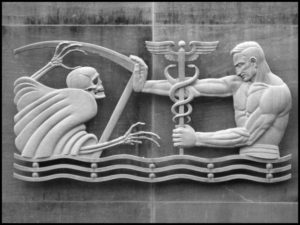
Fending Off Death 1 by wiebkefesch on DeviantArt
Doctors are – in the main – trained to prevent death. Modern medicine has made huge advances, and life expectancies continue to rise. However, there remains only one certainty in this life – that we are all going to die.
Patients in the last year of life are common in hospital. Data from a 2014 study showed that nearly 30% of patients in hospital are actually in the last 12 months of their lives. However, identifying these patients, and appropriately managing their last few months of life is notoriously difficult in those patients with chronic diseases like COPD, and in patients where multi-morbidity makes such predictions even more complex.
Patients receiving palliative chemotherapy for lung or colorectal carcinomas have been found to have an overly optimistic view of what their palliative treatments will achieve. A 2012 study published in the NEJM showed that patients with stage IV disease overwhelmingly (93.6%) opted for chemotherapy treatments. And of those that received chemotherapy, 69% of those with lung, and 81% of those with colorectal cancers wrongly felt that the treatment might offer a chance of a cure.
A study published recently in the PMJ from Dr Jeba and colleagues in Tamil Nadu looked at the prevalence of collusion during consultations with patients being seen in their palliative care clinic. The authors defined collusion as consultations where information was withheld from the patient primarily at the request of family members. There was surprising number of patients who made it to the palliative care clinic without knowing their diagnosis at all (18%), and collusion regarding diagnosis or prognosis was present in 40% of cases referred. Of these, within a month 58% had had this collusion addressed. The remaining cases were thought to be those where the family request for information to be withheld was very strong and persistent.
The study looked at factors which might be associated with collusion and found that collusion was more prevalent where female patients were affected, and was more prevalent amongst patients whose occupation involved manual labour. It was felt that cultural norms will have led to a bias against women being fully involved in decision making. Manual labour may have been a surrogate for educational attainment – and it is well described that less educated patients often have less information needs.
Fascinatingly, the study also revealed that if the family member attending the clinic was the spouse of the patient, collusion was very much less likely. Perhaps the presence of one who knows the other so well simply means there are less opportunities to hide feelings and knowledge. Other than trying to ensure that the spouse was present when a diagnosis was being discussed, no firm conclusions were made.
These three scenarios – doctors chasing an illusion of wellbeing – patients believing in a treatment will do what it emphatically cannot – and finally collusion between treating doctors and relatives – are all important reminders that doctors hold a vital position of power, and how we wield this power has a significant impact on the patients we consult with, treat and comfort.
The delusions, illusions and collusions we all engage in as physicians are well-intentioned, but as the internet democratises information, and patients are no longer so willing to be advised directly on a course of action or of treatment – doctors must change.
We must truly reflect on our interactions with patients – and work out if we are peddling a myth, and if we are, why? Is it our own biases, experiences or fears? And if we are acting in the best interests of the patients – have we actually given them an opportunity to express their opinion?
I suspect that if we do each of these things – we might find that the ones who have been a little deluded – chasing an illusion – are ourselves.